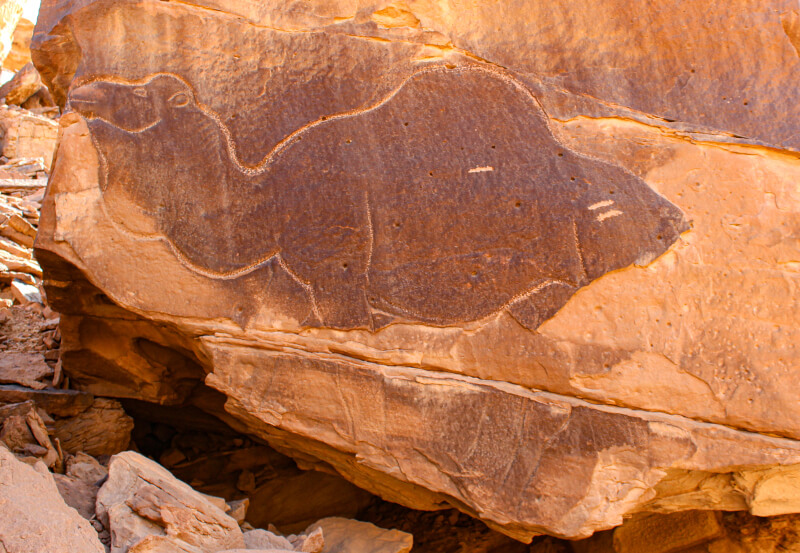
Monumental Sandstone Reliefs from the Neolithic: New Insights from the Camel Site in Saudi Arabia
july 2022 | Vol. 10.7
By Maria Guagnin, Guillaume Charloux, and Abdullah M. AlSharekh
Today the austere deserts of Saudi Arabia evoke images of wandering nomads. But in late prehistory Saudi Arabia was surprisingly green and hospitable, the product of a humid period that lasted for at least four thousand years. One familiar figure, however, that unites the two scenes are camels.
The reliefs of the so-called Camel Site are located on a small cluster of three sandstone spurs, surrounded by fields and small farms on the outskirts of the modern city of Sakaka in al-Jawf Province in northern Saudi Arabia (Figure 1). The site was first recorded in 2016, after it was reported by Hussain Al‐Khalifah, the former representative of the Jawf region for what is now the Heritage Commission of the Ministry of Culture. Since 2018 an international Saudi-French-German team has studied the site.
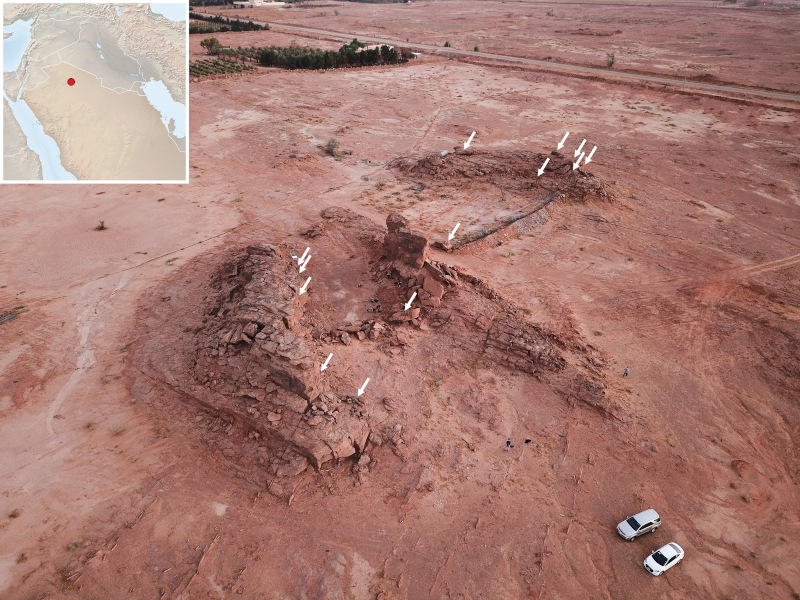
Figure 1. Aerial photo of the Camel Site, with arrows marking the location of panels with life-sized reliefs. © Maria Guagnin and Guillaume Charloux
To establish the age of any engraved rock art is challenging. Unlike painted rock art, there is no organic pigment that could be radiocarbon dated. The dating of engraved rock art therefore requires more complex analyses of overlays – where they exist – of the relative differences in the amount of desert varnish that has accumulated on the rock surface over time, as well as of the context and content of the images.
Events such as the introduction of domesticated livestock can be dated in the archaeological record, and the depiction of livestock species must therefore post-date rock art depictions. These correlations can then be used to anchor the relative sequence visible in superimpositions. Comparisons of rock art depictions with similar content or stylistic traits are therefore important. But because the reliefs at the camel site are unique (Figure 2), and only found at one site, the process of establishing an approximate age for the engravings had to start from scratch. In a first assessment of the site, the camel reliefs were compared to the only other known life-sized camel representations, which are found in the Siq in Petra and are of Nabataean age. However, detailed analysis of the carved reliefs and the wider context of the Camel Site led us to revise this initial age estimate.

Figure 2. Ground view of the most complete relief at the Camel Site, showing the legs, abdomen and body of a camel high up on a cliff. © Maria Guagnin
The reliefs are extremely eroded, and none of the carvings have survived intact. The formation of rock varnish has led to case hardening, which has toughened the outer layer of the rock. However, once erosion penetrates this outer shell, fragments of the reliefs are quickly lost. In addition, hollowing out of the supporting sandstone blocks has caused several panels to fall. Nevertheless, in some areas the surface of the original relief has been preserved and toolmarks remain visible.
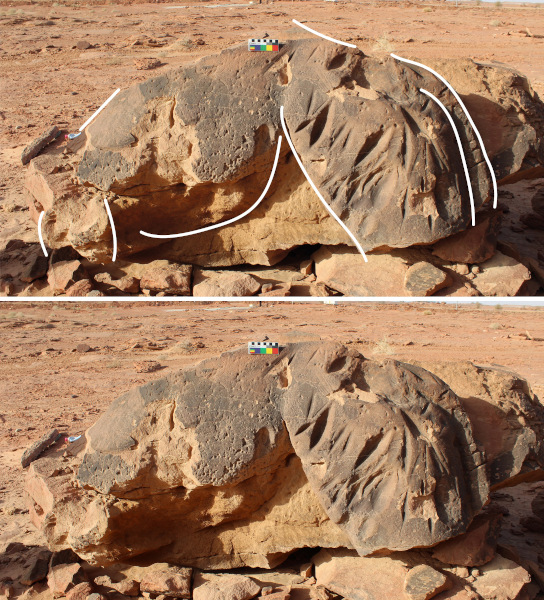
Figure 3. On Panel 1 parts of the body, upper hind leg and tail of a camel, marked with multiple grooves, has survived the fall of the panel from the top of a rock spur. © Maria Guagnin

Figure 4. Top: Panel 3, showing the body, front leg and neck of an equid, with the head apparently lowered down as if to graze or drink. Bottom: The rock surface of Panel 3 has been preserved due to case hardening, but the interior of the boulder has been hollowed out and the panel will likely fall in the near future. © Guillaume Charloux and Maria Guagnin
Analysis of these toolmarks revealed that the reliefs were likely carved using stone tools – for us a first indication that the reliefs may be older than initially thought. Where the rock varnish is preserved, a portable XRF device was used to measure the density of the main elements making up the varnish – specifically manganese and iron. Results suggest that the varnish on Panel 1 is close to maximum density, a process that is known to have taken up to 8000 years. These findings were further supported by the fact that a detailed survey of the site revealed finds of Neolithic and Middle Palaeolithic stone tools, but no later material culture such as pottery. We also found a number of stone tools, with traces consistent of having been used to carve sandstone. Finally, excavation of a test trench at the base of one of the rock spurs revealed Neolithic stone tools and arrowheads, a small number of beads and rich faunal remains which could be radiocarbon dated to around 5300 BCE.
The combined evidence thus suggests that the site was in use in the late 6th millennium BCE, although it remains unclear how much earlier or later the reliefs were carved. Differences between individual animal reliefs, and the presence of grooves and alterations suggest that the site and its reliefs were carved and re-carved over a prolonged period, perhaps centuries or even millennia. Optically Stimulated Luminescence dating of the sediment beneath one of the fallen fragments – a method that calculates when sand was last exposed to sunlight – also revealed that the fragments fell at least 3000 years ago, and that erosion of the reliefs must have already been at an advanced stage.
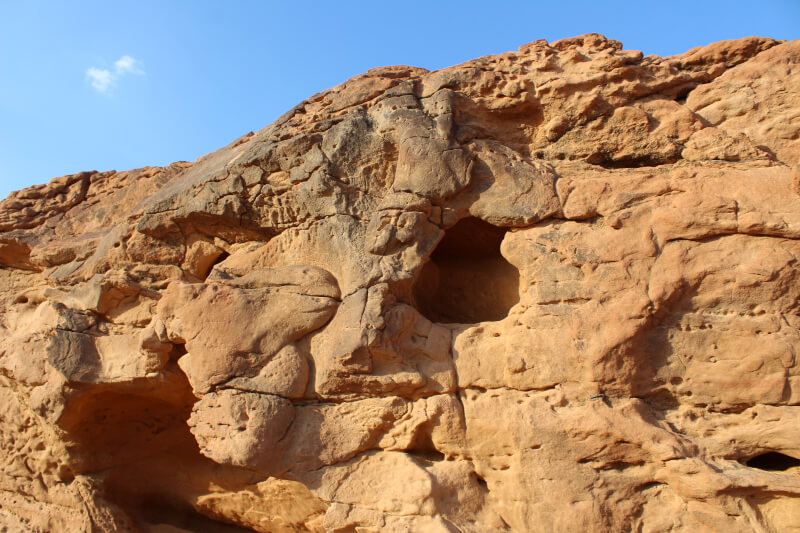
Figure 5. Panel 2 showing a camel (left) and a young equid (right) nose to nose. On the head of the camel the nostril and lips have been preserved, showing extraordinary attention to detail. The bulging neckline identifies this carving as a male camel in rut. Of the equid on the right only the head is clearly visible, although the shape and outline of the body and front leg are still visible. Around the muzzles of both animals tool marks can still be clearly identified. © Camel Site Archaeological Project
The carved reliefs at the Camel Site are unique – not only for the rock art of Arabia, but across the world. Carving of reliefs of this size would have required extraordinary technological skill. Carvers had to work at height. While remains of small working platforms are visible at two of the panels, most would have been carved either using simple ladders or some sort of scaffolding or rigging. While working on any body part carvers were also unable to see the whole sculpture, making it all the more astonishing that the reliefs are completely naturalistic and in proportion.

Figure 6. Detail photograph of Panel 8, showing the head and bulging neck of a male camel in rut, with detailed representation of the camel’s mouth and eye. © Guillaume Charloux
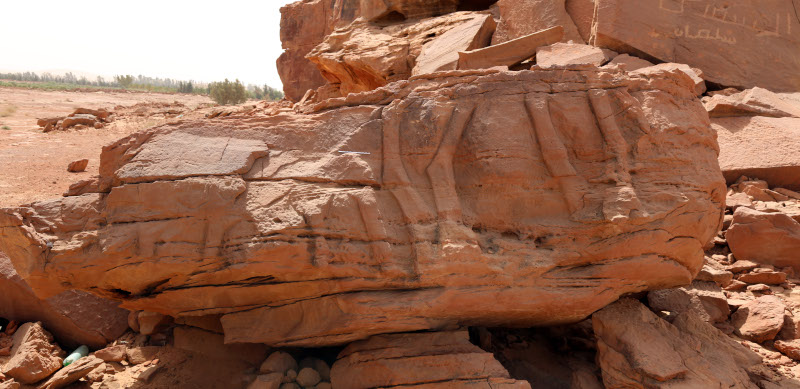
Figure 7. Panel 10 with the legs of two large camels on a boulder that has fallen and landed upside down. The bone structure and ligaments of the legs are clearly depicted. © Camel Site Archaeological Project
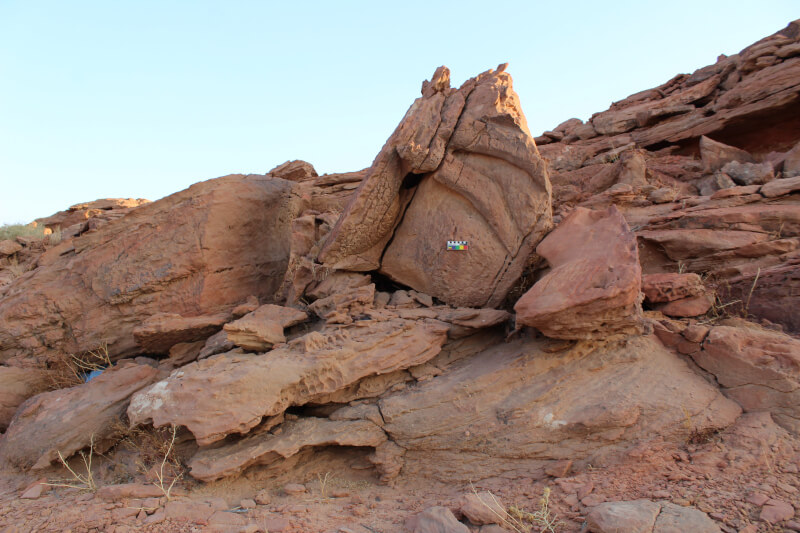
Figure 8. Fragments of Panel 5/6/7, showing the abdomen and hind legs of a camel. The front legs and hump were found on adjacent fragments. © Camel Site Archaeological Project
Where the original rock surface is preserved, the carvings show an extraordinary level of detail; lips, eyes and even the ligaments beneath the skin were depicted. Reliefs were likely carved by teams, with one person working on removing the bulk of the rock to reveal the shape of the body – particularly below the abdomen and between the legs many of the reliefs required the removal of substantial amounts of rock (see for example Figure 2 and Figure 8). Working practises of modern stonemasons suggest that the finer work of carving the surface and polishing it was likely carried out by a different, more experienced person. High-reliefs would have taken up to two weeks to carve, and involved a whole team working to procure the raw material for the stone tools, shaping the stone tools, and then frequently re-sharpening them, building rigging, and bringing water and food. The investment of time and effort and the level of planning that would have been involved clearly sets the Camel Site apart from conventional, two-dimensional rock art sites in the region, which would have been produced over a much shorter time span.
Engravings, rather than reliefs, of large, naturalistic camels are also known from other sites in northern Arabia, in the region near the Camel Site, as well as from sites south and west of the Nefud desert. In some cases, these carvings have part of the body carved in low relief. It therefore appears that the Camel Site is a three-dimensional, monumental expression of a more widespread tradition of camel representations. As two-dimensional carvings tend to be better preserved, this provides further insights into the reliefs at the Camel Site. In most cases camels are clearly depicted with a bulging neck, a sign of a male camel in rut.

Figure 9. Camel engraving near Dumat al-Jandal, showing a detailed carving of a male camel in rut that has been re-worked multiple times. The outline has recently been scratched, giving it a lighter colour. The original line of the abdomen, the legs, and details of the neck have retained their original desert varnish. © Maria Guagnin

Figure 10. Detailed camel engraving near Dumat al-Jandal. The legs, abdomen and lower neck are clearly visible and details such as the texture of the coat and the callosities on the legs are identifiable. Part of the hump remains visible above a crack in the boulder. © Maria Guagnin
In feral camels the mating season coincides with the end of the wet season, when vegetation is most abundant. The fact that all camel representations show animals that are clearly well fed appears to support this seasonal correlation. At the Camel Site, the neck is only preserved in two of the camel carvings, and in both cases the bulging neckline is clearly visible (Figure 5 and Figure 6). It is therefore possible that the reliefs are part of a symbolism that references either the mating season, or the end of the wet season.
The reliefs at the Camel Site thus provide unique insights into the yearly rhythm of the seasons and their symbolism for Neolithic populations, who appear to have come together at this location to make reliefs, to modify older reliefs, and to mark reliefs with grooves, repeatedly and over many generations.
Maria Guagnin is a post-doctoral researcher at the Max Planck Institute for the Science of Human History.
Guillaume Charloux is a researcher at the Centre National de la Recherche Scientifique.
Abdullah M. AlSharekh is Associate Professor in the Department of Archaeology and Museums at King Saud University.
Acknowledgements:
We wish to thank HRH Prince Badr Bin Abdullah Bin Mohammed Bin Farhan Al-Saud, Minister of Culture, and to HRH Prince Sultan Bin Salman Bin Abdulaziz al-Saud, the former President of the Saudi Commission for Tourism and National Heritage (SCTH) for giving us permission to carry out research at the Camel Site. Main funding bodies of fieldwork and research were a grant from the Gerda Henkel Foundation (Grant No AZ 43_V_18, to MG and GC), the CNRS (to GC), Labex Resmed ANR-10- LABX-72 / ANR-11-IDEX-0004-02 (to GC), the French Ministry of Foreign Affairs and the French embassy in Riyadh (to GC), and the Dahlem Research School at Freie Universität Berlin (to MG).
Further Reading:
Charloux, G., Guagnin, M. & Norris, J. 2020. Large-sized camel depictions in western Arabia: A characterisation across time and space. Proceedings of the Seminar for Arabian Studies, 50, 85-108.
Gauthier-Pilters, H. & Dagg, A. I. 1981. The Camel. Its Evolution, Ecology, Behaviour, and Relationship to Man, Chicago: The University of Chicago Press.
Guagnin, M., Charloux, G., AlSharkeh, A. M., Crassard, R., Hilbert, Y. H., Andreae, M. O., Preusser, F., DuBois, F., Burgos, F., Flohr, P., Stewart, M., Mora, P., AlQaeed, A. & AlAli, Y. 2021. Life-sized Neolithic camel sculptures in Arabia: A scientific assessment of the craftsmanship and age of the Camel Site reliefs. Journal of Archaeological Science: Reports, 103165.
How to cite this article
Guagnin, M., Charloux, G., and A. M. AlSharekh. 2022. “Monumental Sandstone Reliefs from the Neolithic: New Insights from the Camel Site in Saudi Arabia.” The Ancient Near East Today 10.7. Accessed at: https://anetoday.org/guagnin-camel-site-reliefs/.
Want to learn more?
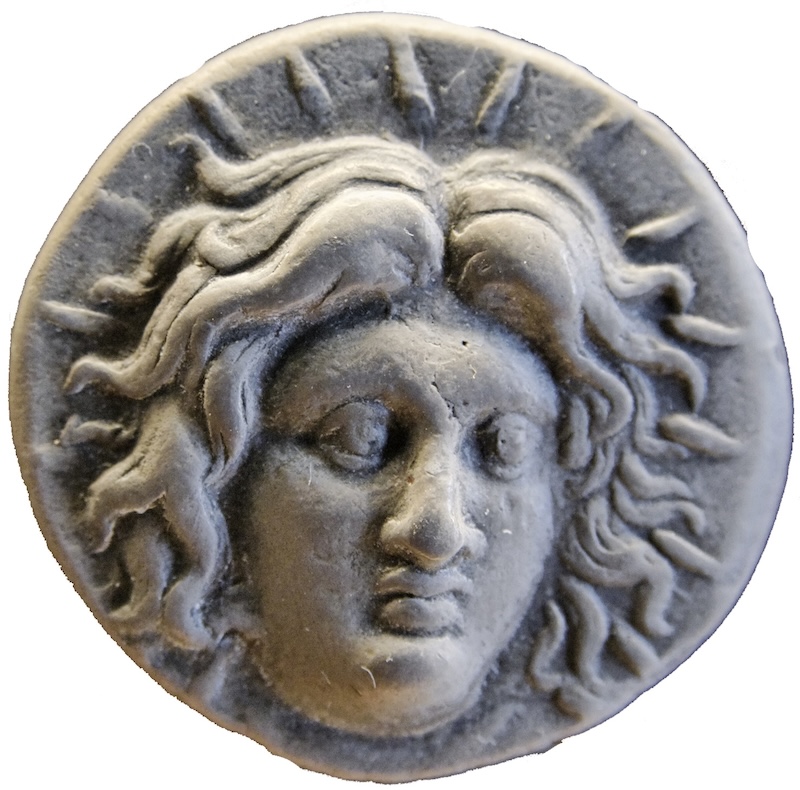




Post a comment